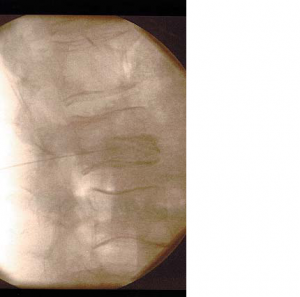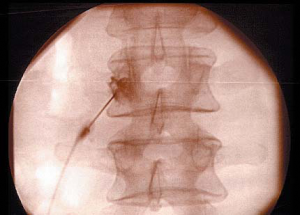GENERAL
As described more analytically in the chapter of intradiscal degenerative disease, the intervertebral disc is innervated by the recurrent meningeal nerve (at each side of the spine) conveying pain signals of nociceptors from the posterior annulus fibrosus (envelope of the disc) to the ramus communicans of the sympathetic chain, then to the posterior spinal root ganglion and finally to the spinal cord. (7,9,25)
Nakamura et al conducted studies to observe the afferent nerve pathways responsible for discogenic pain of lower lumbar levels, by blocking the 2nd lumbar root bilaterally in 33 patients. Based on their findings, the writers concluded that the 2nd lumbar root may probably be the most important afferent pathway of discogenic pain in lower lumbar levels, mainly through the afferent sympathetic fibres of the recurrent meningeal nerve. Infiltration of the 2nd lumbar root may be useful for the diagnosis and therapy of discogenic pain.
Chandler et al investigated the application of the ramus communicans nerve block as treatment for pain due to vertebral fractures. Oh και Shim studied the efficacy of conventional radiofrequency and ablation applied on the ramus communicans of the sympathetic chain in 49 patietns with discogenic pain at one lumbar level. (1,2,8)
All investigators concluded that ablation of the sympathetic ramus communicans is effective in treating discogenic pain from intradiscal degeneration and pain from vertebral fracture. The duration of the result still remains unpredictable.
INDICATIONS
• Discogenic pain due to intradiscal degeneration
• Vertebral body fracture
The patient is placed in the prone position under conscious light sedation. Using an oblique fluoroscopic view of approximately 200, the needle entry point is marked with a radiopaque metallic forceps on the skin to the site corresponding to the lateral margin of the vertebra below the transverse process. Following local anaesthesia at the entry point and with the needle advancing more deeply, another needle with a bent end is inserted dorsally moving slowly under fluoroscopic guidance, until it comes in contact with the vertebral body. At this point, a lateral fluoroscopic view is used. The end of the needle is advanced slightly in advance to the posterior margin of the vertebral body and in contact with it. Contrast medium is injected (0,5ml) and anteroposterior and another lateral fluoroscopic view are taken again to ensure the proper site of the needle. Then, 1 ml local long-acting anaesthetic is administered for selective block of the ramus communicans. For every painful disc, the block is performed to the adjacent superior and inferior vertebra.
 RADIOFREQUENCY APPLIED TO RAMUS COMMUNICANS
RADIOFREQUENCY APPLIED TO RAMUS COMMUNICANS
Radiofrequency application to ramus communicans is the same technique as in the diagnostic block, with the only difference that a special needle with an active metallic end 2mm is used for inserting an electrode connected with a radiofrequency generator. After the proper needle site has been confirmed, sensory testing is conducted during which the patient should feel mild paraesthesia or pressure or tingling or pain in the low back. The needle tip point is corrected with fine movements until the desirable result of the sensory test is achieved. Then, motor testing is applied to check whether the needle tip is near a motor nerve, something that would cause contraction of lower limb muscles. Should this occur, the needle is moved to localize the point where there is a positive sensory test result (paraesthesia etc) with low-tension current and a negative motor test result with high-tension current (no lower limb movement). (1,2,8)
LITERATURE
1. Guyatt G, Gutterman D, Baumann MH, et al.
Grading strength of recommendations and quality of evidence
in clinical guidelines: report from an american college of chest
physicians task force. Chest. 2006;129:174–181.
2. van Kleef M, Mekhail N, van Zundert J. Evidencebased
guidelines for interventional pain medicine according to
clinical diagnoses. Pain Pract. 2009;9:247–251.
3. Kuslich SD, Ulstrom CL, Michael CJ. The tissue
origin of low back pain and sciatica: a report of pain response
to tissue stimulation during operations on the lumbar spine
using local anesthesia. Orthop Clin North Am. 1991;22:181–
187.
4. Schwarzer AC, Aprill CN, Derby R, Fortin J, Kine G,
Bogduk N. The relative contributions of the disc and zygapophyseal
joint in chronic low back pain. Spine. 1994;19:
801–806.
5. Cohen SP, Larkin TM, Barna SA, Palmer WE, Hecht
AC, Stojanovic MP. Lumbar discography: a comprehensive
review of outcome studies, diagnostic accuracy, and principles.
Reg Anesth Pain Med. 2005;30:163–183.
576 • kallewaard et al.
6. Groen GJ, Baljet B, Drukker J. Nerves and nerve
plexuses of the human vertebral column. Am J Anat. 1990;
188:282–296.
7. Suseki K, Takahashi Y, Takahashi K, Chiba T,
Yamagata M, Moriya H. Sensory nerve fibres from lumbar
intervertebral discs pass through rami communicantes. A possible
pathway for discogenic low back pain. J Bone Joint Surg
Br. 1998;80:737–742.
8. Oh WS, Shim JC. A randomized controlled trial of
radiofrequency denervation of the ramus communicans nerve
for chronic discogenic low back pain. Clin J Pain. 2004;
20:55–60.
9. Nakamura SI, Takahashi K, Takahashi Y, Yamagata
M, Moriya H. The afferent pathways of discogenic low-back
pain. Evaluation of L2 spinal nerve infiltration. J Bone Joint
Surg Br. 1996;78:606–612.
10. Schwarzer AC, Aprill CN, Derby R, Fortin J, Kine G,
Bogduk N. The prevalence and clinical features of internal disc
disruption in patients with chronic low back pain. Spine.
1995;20:1878–1883.
11. Ohnmeiss DD, Vanharanta H, Ekholm J. Relation
between pain location and disc pathology: a study of pain
drawings and CT/discography. Clin J Pain. 1999;15:210–217.
12. Ohnmeiss DD, Vanharanta H, Ekholm J. Relationship
of pain drawings to invasive tests assessing intervertebral
disc pathology. Eur Spine J. 1999;8:126–131.
13. Vanharanta H. The intervertebral disc: a biologically
active tissue challenging therapy. Ann Med. 1994;26:395–
399.
14. Carragee EJ, Hannibal M. Diagnostic evaluation of
low back pain. Orthop Clin North Am. 2004;35:7–16.
15. Zhou Y, Abdi S. Diagnosis and minimally invasive
treatment of lumbar discogenic pain—a review of the literature.
Clin J Pain. 2006;22:468–481.
16. Ito M, Incorvaia KM, Yu SF, Fredrickson BE, Yuan
HA, Rosenbaum AE. Predictive signs of discogenic lumbar
pain on magnetic resonance imaging with discography correlation.
Spine. 1998;23:1252–1258; discussion 9–60.
17. Gilbert FJ, Grant AM, Gillan MG, et al. Low back
pain: influence of early MR imaging or CT on treatment and
outcome—multicenter randomized trial. Radiology. 2004;
231:343–351.
18. Wolfer LR, Derby R, Lee JE, Lee SH. Systematic
review of lumbar provocation discography in asymptomatic
subjects with a meta-analysis of false-positive rates. Pain Physician.
2008;11:513–538.
19. Coppes MH, Marani E, Thomeer RT, Groen GJ.
Innervation of “painful” lumbar discs. Spine. 1997;22:2342–
2349; discussion 9–50.
20. Freemont AJ, Peacock TE, Goupille P, Hoyland JA,
O’Brien J, Jayson MI. Nerve ingrowth into diseased intervertebral
disc in chronic back pain. Lancet. 1997;350:178–181.
21. Hurri H, Karppinen J. Discogenic pain. Pain. 2004;
112:225–228.
22. Peng B, Hao J, Hou S, et al. Possible pathogenesis
of painful intervertebral disc degeneration. Spine (Phila Pa
1976). 2006;31:560–566.
23. Peng B, Chen J, Kuang Z, Li D, Pang X, Zhang X.
Expression and role of connective tissue growth factor in
painful disc fibrosis and degeneration. Spine (Phila Pa 1976).
2009;34:E178–E182.
24. Peng B, Wu W, Hou S, Li P, Zhang C, Yang Y. The
pathogenesis of discogenic low back pain. J Bone Joint Surg
Br. 2005;87:62–67.
25. Freemont AJ, Watkins A, Le Maitre C, et al. Nerve
growth factor expression and innervation of the painful
intervertebral disc. J Pathol. 2002;197:286–292.
26. Freemont AJ. The cellular pathobiology of the degenerate
intervertebral disc and discogenic back pain. Rheumatology
(Oxford). 2009;48:5–10.
27. Sachs BL, Vanharanta H, Spivey MA, et al. Dallas
discogram description. A new classification of CT/discography
in low-back disorders. Spine. 1987;12:287–294.
28. Vanharanta H, Sachs BL, Spivey MA, et al.
The relationship of pain provocation to lumbar disc deterioration
as seen by CT/discography. Spine. 1987;12:295–
298.
29. Willems PC, Jacobs W, Duinkerke ES, De Kleuver
M. Lumbar discography: should we use prophylactic antibiotics?
A study of 435 consecutive discograms and a systematic
review of the literature. J Spinal Disord Tech. 2004;17:243–
247.
30. Carragee EJ, Don AS, Hurwitz EL, Cuellar JM,
Carrino J, Herzog R. Does discography cause accelerated progression
of degeneration changes in the lumbar disc: a ten-year
matched cohort study. Spine (Phila Pa 1976). 2009;34:2338–
2345.
31. O’Neill C, Kurgansky M. Subgroups of positive discs
on discography. Spine. 2004;29:2134–2139.
32. Seo KS, Derby R, Date ES, Lee SH, Kim BJ, Lee CH.
In vitro measurement of pressure differences using manometry
at various injection speeds during discography. Spine J. 2007;
7:68–73.
33. Shin DA, Kim SH, Han IB, Rhim SC, Kim HI.
Factors influencing manometric pressure during pressurecontrolled
discography. Spine (Phila Pa 1976). 2009;34:
E790–E793.
34. Bogduk N. Provocation discography: lumbar
disc stimulation. In: ISIS, ed. Practice Guidelines for Spinal
Diagnostic and Treatment Procedures. Seattle, WA: International
Spine Intervention Society; 2004:20–46.
35. Merskey H, Bogduk N. Classification of Chronic
Pain: Descriptions of Chronic Pain Syndromes and Definitions
of Pain Terms. 2nd ed. Seattle, WA: IASP Press; 1994.
36. Saboeiro GR. Lumbar discography. Radiol Clin
North Am. 2009;47:421–433.
37. Derby R, Howard MW, Grant JM, Lettice JJ, Van
Peteghem PK, Ryan DP. The ability of pressure-controlled
15. Discogenic Pain • 577
discography to predict surgical and nonsurgical outcomes.
Spine. 1999;24:364–371; discussion 71–72.
38. Koes BW, van Tulder MW, Peul WC. Diagnosis and
treatment of sciatica. BMJ. 2007;334:1313–1317.
39. Luijsterburg PA, Verhagen AP, Ostelo RW, et al.
Physical therapy plus general practitioners’ care versus general
practitioners’ care alone for sciatica: a randomised clinical
trial with a 12-month follow-up. Eur Spine J. 2008;17:509–
517.
40. Luijsterburg PA, Verhagen AP, Ostelo RW, van Os
TA, Peul WC, Koes BW. Effectiveness of conservative treatments
for the lumbosacral radicular syndrome: a systematic
review. Eur Spine J. 2007;16:881–899.
41. Buttermann GR. The effect of spinal steroid
injections for degenerative disc disease. Spine J. 2004;4:495–
505.
42. Simmons JW, McMillin JN, Emery SF, Kimmich SJ.
Intradiscal steroids. A prospective double-blind clinical trial.
Spine. 1992;17:S172–S175.
43. Khot A, Bowditch M, Powell J, Sharp D. The use of
intradiscal steroid therapy for lumbar spinal discogenic pain:
a randomized controlled trial. Spine. 2004;29:833–836;
discussion 7.
44. Muzin S, Isaac Z, Walker J 3rd. The role of intradiscal
steroids in the treatment of discogenic low back pain.
Curr Rev Musculoskelet Med. 2008;1:103–107.
45. Klein RG, Eek BC, O’Neill CW, Elin C, Mooney V,
Derby RR. Biochemical injection treatment for discogenic low
back pain: a pilot study. Spine J. 2003;3:220–226.
46. Derby R, Eek B, Lee SH, Seo KS, Kim BJ. Comparison
of intradiscal restorative injections and intradiscal electrothermal
treatment (IDET) in the treatment of low back pain.
Pain Physician. 2004;7:63–66.
47. Saal JA, Saal JS. Intradiscal electrothermal treatment
for chronic discogenic low back pain: a prospective outcome
study with minimum 1-year follow-up. Spine. 2000;25:2622–
2627.
48. Freeman BJ. IDET: a critical appraisal of the
evidence. Eur Spine J. 2006;15(suppl 3):S448–S457.
49. Urrutia G, Kovacs F, Nishishinya MB, Olabe J.
Percutaneous thermocoagulation intradiscal techniques for
discogenic low back pain. Spine. 2007;32:1146–1154.
50. Pauza KJ, Howell S, Dreyfuss P, Peloza JH, Dawson
K, Bogduk N. A randomized, placebo-controlled trial of intradiscal
electrothermal therapy for the treatment of discogenic
low back pain. Spine J. 2004;4:27–35.
51. Appleby D, Andersson G, Totta M. Meta-analysis of
the efficacy and safety of intradiscal electrothermal therapy
(IDET). Pain Med. 2006;7:308–316.
52. Kapural L, Mekhail N, Hicks D, et al. Histological
changes and













